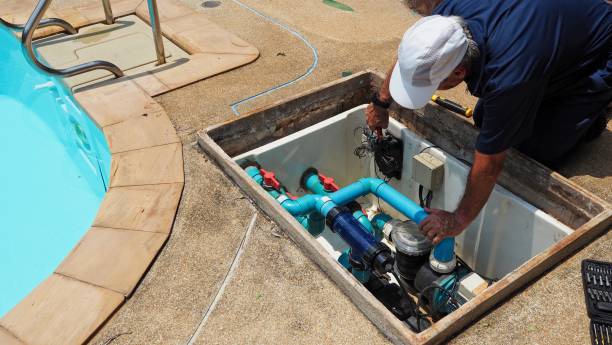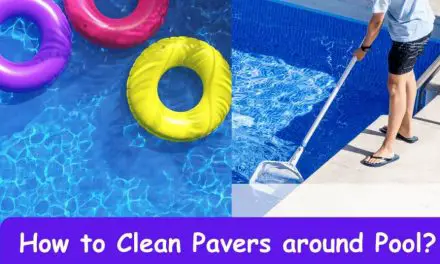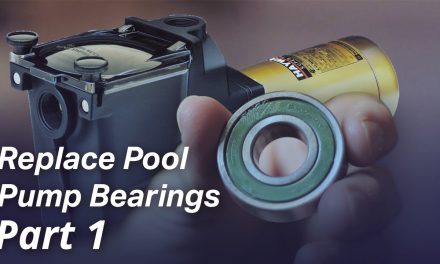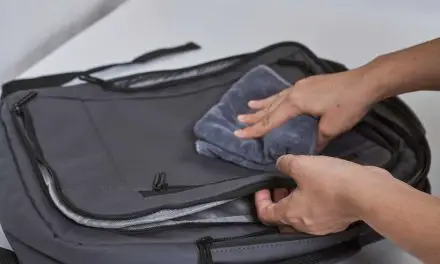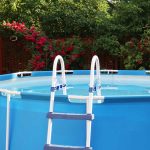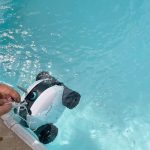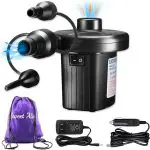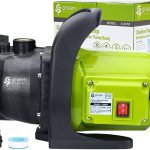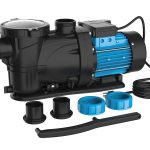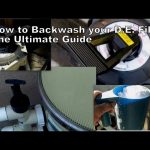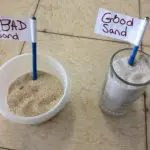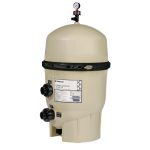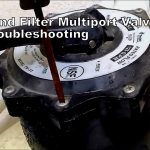To fix a pool pump, troubleshoot common problems such as a pump that doesn’t turn on, low flow rate, leaks, air suction, noisy operation, or a basket that doesn’t fill with water. Check valves, water levels, clean the pump basket, inspect the pump lid O-ring, check for suction side leaks, run water over suspected areas, and unclog the impeller if necessary.
Additionally, prime the pump by turning the multiport valve to recirculate, removing winter pool plugs, filling the pump with water using a hose, and turning on the pump. Make sure the motor has the right voltage, and check for blockages if the motor isn’t rotating.

Credit: www.amazon.com
Leaking
A leaking pool pump can be a frustrating problem to deal with. There can be several causes for pool pump leaks, including worn-out O-rings, cracked pump casings, or loose fittings. To detect leaks in a pool pump, you can inspect the pump for any visible signs of water leakage, such as wet spots or puddles around the pump.
Additionally, you can perform a pressure test by shutting off the pump and monitoring the pressure gauge for any drops. Once you have determined the source of the leak, you can take steps to fix it. This may involve replacing the O-rings, tightening the fittings, or even replacing the entire pump casing if necessary.
It is important to address pool pump leaks promptly to avoid further damage to the pump and ensure proper pool circulation.
Above Ground
Troubleshooting and repairing above ground pool pumps can be a straightforward process. Common issues with above ground pool pumps include low flow, leaking, filter problems, cavitation, noise, and no flow. To fix these problems, start by checking the valves, water level, and cleaning out the pump basket.
Make sure the pump lid O-ring is in good condition and check for suction side leaks. Running a garden hose over suspected areas can help identify any leaks. Clogged impellers can also cause low flow, so it’s essential to inspect and clean them.
If the pump isn’t priming properly, try turning the multiport valve to “Recirculate” and fill the pump with water using a hose. Troubleshooting tips for priming the pump include removing winter pool plugs and turning on the pump. Remember to follow these guidelines to ensure your above ground pool pump is functioning effectively.
Low Flow
A low flow rate in a pool pump can be caused by various reasons. One possible cause is a clogged filter, preventing water from flowing freely. Another reason could be air leakage in the suction lines, causing a decrease in flow.
Additionally, a worn-out impeller can also lead to reduced flow rate. Poor water level in the pool can also contribute to low flow. To improve the flow rate, make sure to regularly clean and maintain the filter. Check for any leaks in the suction lines and repair them if necessary.
Replace the impeller if it is damaged or worn out. Finally, ensure that the water level in the pool is adequate. By addressing these issues, you can effectively increase the flow rate of your pool pump.
Filter
The pool pump filter plays a crucial role in keeping your pool clean and functioning properly. A clean and well-maintained filter is essential for ensuring the water quality and preventing debris from clogging the pump. To clean and maintain a pool pump filter, follow these six guidelines: First, turn off the pump and close the valves to prevent any water from flowing into the filter.
Next, remove the filter lid and carefully lift out the filter cartridge or grids. Rinse them thoroughly with water to remove any dirt or debris. Inspect the filter for cracks or damage and replace any worn-out parts. Reassemble the filter and secure the lid tightly.
Finally, turn on the pump and check for proper water flow. Regular maintenance of your pool pump filter is essential to ensure good water circulation and a sparkling clean pool.
Cavitation
Cavitation is a common issue in pool pumps that can affect its performance. Cavitation occurs when air bubbles form in the water and collapse, causing damage to the pump. To prevent cavitation, it is important to ensure that the pool pump is properly primed and that there are no leaks in the system.
Additionally, maintaining the proper water level in the pool and regularly cleaning the pump basket can help prevent cavitation. If cavitation does occur, it can be fixed by adjusting the pool pump’s flow rate, checking for and fixing any leaks, and ensuring that the pump is properly primed.
Regular maintenance and inspection of the pool pump can help prevent and fix cavitation issues, ensuring that the pump operates efficiently and effectively.
Noisy
A noisy pool pump can be quite frustrating, but understanding the common causes and implementing methods to reduce the noise can help restore peace to your pool area. The most common causes of noise in a pool pump are cavitation, a clogged impeller, or loose motor components.
Cavitation occurs when there is insufficient water flow in the pump, leading to the formation of air bubbles that collapse with force, causing noise. A clogged impeller restricts water flow, resulting in vibrations and noise. Loose motor components, such as the fan or motor mount, can also create rattling and humming sounds.
To reduce the noise, ensure proper water flow by cleaning the pump basket and removing any debris. Check the impeller for clogs and clean or replace it if necessary. Tighten any loose motor components and consider using vibration-dampening materials. Regular maintenance and proper lubrication can also help keep the pump running smoothly and quietly.
No Flow
If you’re facing the issue of no flow in your pool pump, there could be several reasons behind it. One common cause is a clogged impeller, which restricts the flow of water. Another possibility is a suction side leak, where air enters the system instead of water.
Additionally, a low water level in the pool or a dirty pump basket can also hamper the flow. To fix these issues, start by cleaning out the pump basket and checking for any debris. Next, check the valves and ensure they are functioning properly.
If you suspect a suction side leak, run a garden hose over the suspected areas to identify and fix the leak. Finally, if these steps don’t resolve the issue, it’s recommended to contact a pool professional for further assistance.
Troubleshooting A Pool Pump That Is Not Fully Priming
To troubleshoot a pool pump that is not fully priming, follow these steps to ensure proper priming: 1. Check the pool valves to ensure they are fully open and not restricting the water flow. 2. Verify the water level in the pool is sufficient for the pump to draw water effectively.
3. Clean out the pump basket to remove any debris that may be causing a blockage. 4. Start the pump to see if it engages and begins priming properly. 5. Inspect the pump lid O-ring for any damage or wear and replace if necessary.
6. Look for any leaks on the suction side of the pump and repair as needed. 7. Use a garden hose to run water over suspected areas to identify any air leaks. 8. Check for a clogged impeller, which can reduce water flow and hinder priming.
9. Once the issue is resolved, the pump should start priming and operating efficiently. By following these troubleshooting steps, you can fix a pool pump that is not fully priming and ensure optimal performance for your pool.
How To Quickly Prime A Pool Pump
To quickly prime a pool pump, follow this step-by-step guide. First, ensure the Multiport Valve is set to Recirculate. Then, remove any winter pool plugs. Next, fill the pump with water using a hose. Once the pump is filled, turn it on.
If you encounter any issues during priming, try these troubleshooting tips. Check the valves and water level, clean out the pump basket, and inspect the pump lid O-ring for any leaks. If necessary, run a garden hose over suspected areas to identify suction side leaks.
Additionally, check for a clogged impeller. By following these steps and troubleshooting tips, you can effectively prime your pool pump and ensure it functions properly.
Frequently Asked Questions Of How To Fix A Pool Pump?
What Causes A Pool Pump To Stop Working?
Potential causes for a pool pump to stop working include an overloaded circuit, incorrect voltage, blocked motor vents, and debris jamming the motor shaft.
Can You Repair Pool Pump?
Yes, you can repair a pool pump.
How Do I Know If My Pool Pump Is Damaged?
To determine if your pool pump is damaged, follow these steps: 1. Check if the pump is not turning on or shuts off while running. 2. Verify if the pump is not pumping water or if the flow rate is low.
3. Inspect for leaks in and around the pump. 4. Ensure there is no air being sucked into the pump. If you notice any of these issues, your pool pump may be damaged and may require repairs or replacement.
Conclusion
To conclude, fixing a pool pump can be a manageable task if you follow the right steps. Start by identifying the specific problem you are facing, whether it’s a pump that doesn’t turn on, low flow rate, leaks, or excessive noise.
Then, proceed with troubleshooting techniques such as checking valves, water levels, and cleaning the pump basket. If the pump is not priming, you can try using the recirculate mode, removing winter pool plugs, and filling the pump with water. Additionally, always be mindful of safety precautions and consult a professional if needed.
By taking these steps, you can ensure the efficient and smooth operation of your pool pump, allowing you to enjoy a clean and well-maintained pool throughout the swimming season. Keep these tips in mind and keep your pool pump running smoothly for years to come.

